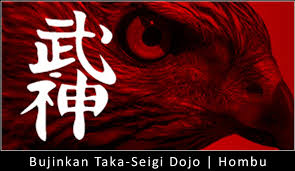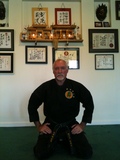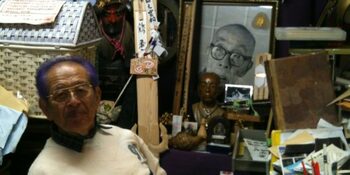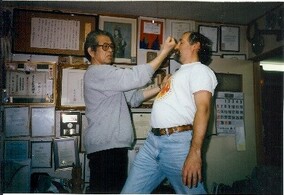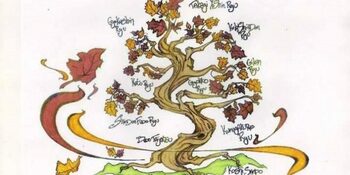
Menkyo Defined
10.12.18
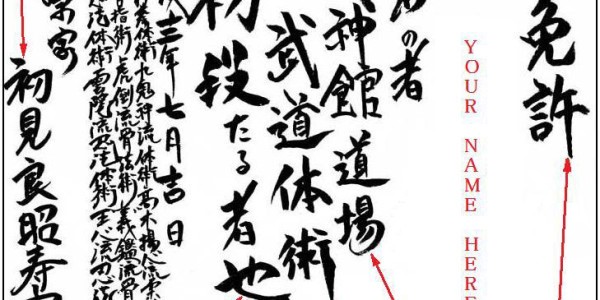
We’ve been discussing the topic of rank lately in our webinars and during the black belt seminar, so I thought this would be a good time to write a short piece on what an authentic Bujinkan menkyo looks like. Pictured below is a copy of an authentic Bujinkan Shodan Menkyo with explanations as to what is written on it and where. The graphic is courtesy of Shihan Brent Earlewine, Pittsburgh BTSD.
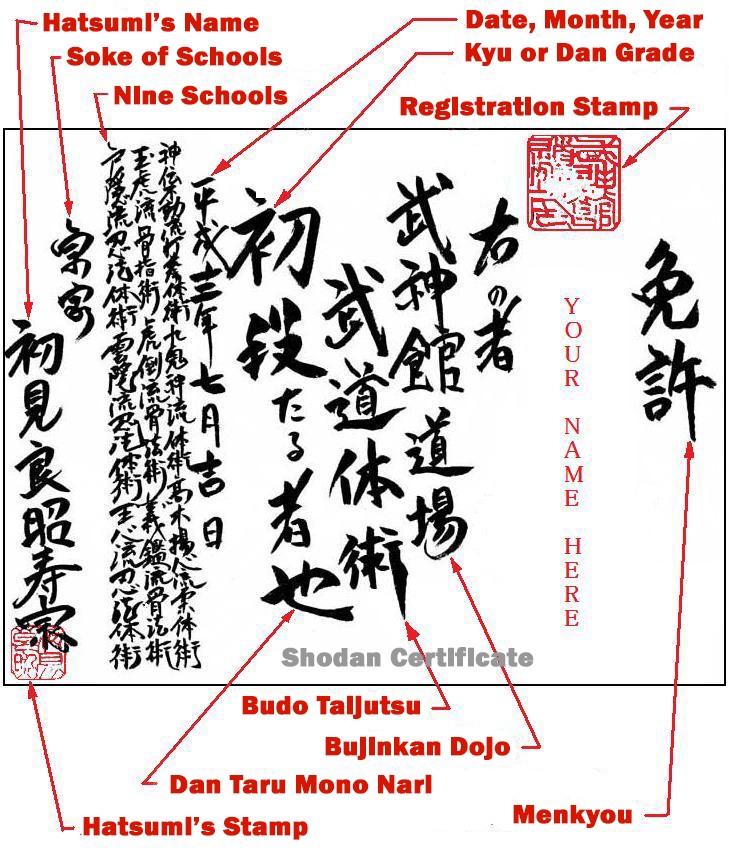
Starting from left and moving right is Hatsumi Soke’s budo name, ‘Hisa Mune’. ‘Hisa’ is the kanji ‘Kotobuki’ (寿) that you see on all kinds of things like chopsticks, coasters, at weddings, etc. It generally means ‘longevity’ and ‘congratulations’. ‘Mune’ is actually the ‘sô’ from ‘Sôke’. It means ‘main point, essence, origin’. Old timers will recall his budo name used to be “Tetsuzan” (Iron Mountain), but when he turned 65 or maybe 70 he changed it to Hisa Mune. He told me that Tetsuzan was a young man’s fighting name that was a challenge to all comers. When he became older he felt it appropriate to change his budo name to a more peaceful one.
Below his name is the official Bujinkan menkyo stamp.
Moving one column to right is his title as Soke of schools.
Next are 3 columns of the nine schools that make up the Bujinkan. You can probably recognize the kanji for the nine schools from various books and videos that Soke has produced.
The next column is for the year, month and day of the current Emperor. The Japanese keep track of the year in several ways. One of course is the western calendar year and another is measured by the lunar (Chinese) year, which starts in late January or early February. A third way is uniquely Japanese in that the years are measured by the reign of the current Emperor. When Emperor Hirohito passed away in January 1989, the Showa era ended and the Japanese year was reset to the year 1 with the coronation of Emperor Akihito. The new Emperor also took on the name of Heisei, meaning Peace, to signify the era of his reign. Japanese will say that this year, 2014, is the 26th year of Heisei, meaning it is the 26th year of Emperor Akihito’s reign. This menkyo pictured is dated Heisei 12, 7th month, 10th day or using a western reference, July 10, 2008. Soke sometimes picks the month and day for menkyo. Usually it’s whatever month/day the promotion is awarded, but often he will pick an auspicious day for someone getting a senior rank. He is big into numerology and the Japanese have good luck days (9th, 10th, 20th, etc.) and bad luck days (4th, 13th). He also likes to use days that have several ways of expression, for example the 20th of the month can be said technically as Niju nichi, but it can also be expressed as Hatsuka. Soke likes to use those types of days I suppose because they are unique and more complex than other days that only can be expressed as a number. He also takes interest in how many strokes of the pen it takes to create the number. If the date you get on your rank is different from the date you were given it, it may be that Soke picked a more auspicious date for your promotion. For my 15th dan for example, he backdated it about a month to coincide with the 33rd year/month/day that Takamatsu Soke passed away.
Continuing to the right, the top kanji will be the rank being given. This one is written for a “Shodan” or 1st degree black belt. Mark provided some interesting information as to why different Kanji are used for 1st, 2nd and 3rd Dan. From Mark: “It should be noted that the ranks written on dan certificates doesn’t completely use the normal number system of kanji… i.e. 一,二,三. ‘Shodan’, is ‘初’ instead of 一, but 1st kyu is a normal 1 (一). Nidan often uses 弐 instead of 二. The idea is that someone could add an extra stroke to it, making it a 3, so these kind of documents usually use a special character so that cannot happen. 3 also is different… 参 instead of 三. From 4 on the numbers are standard.” This was very interesting for me as I never knew why Shodan through Sandan had their own unique kanji. Thanks Maak (pronounced the Japanese way). Below “Shodan” is written Dan Taru Mono Nari. If this was a Kyu menkyo it would be written as Kyu Taru Mono Nari.
Moving onto the next column to the right is written, “Budo Taijutsu.” The old menkyo used to say Ninpo Taijutsu, but Soke changed them in the early 90s to more accurately depict the schools of the Bujinkan. Only three of the nine schools are actually Ninpo based.
The next column we should all recognize as, “Bujinkan Dojo”.
Next are two kanji with the backward “e”, pronounced “no” and being a possessive. This simply states, the person’s name here. Meaning the person’s name that appears to the right is the person that this menkyo is for.
In the top right corner is a larger hanko (chop) that Soke uses for all dan grades from Shodan to JuGodan. Kyu menkyo have only the stamp in the bottom left corner. Shidoshi can readily identify a menkyo if it is a Kyu grade or Dan grade by looking for this stamp.
There is a third hanko Soke uses only for the Godan menkyo. Half of the hanko used for Godan goes on the menkyo itself and the other half goes into your page in Soke’s Shidoshi registry books (scrap books). This is how he registers and tracks students after they make it to Godan/Shidoshi level. This is where he records your future promotions and you annual Shidoshi-kai membership. He does not track promotions or memberships below the rank of Godan. There is a huge shelf of these scrap books for the thousands of Shidoshi from all over the world. They are filed by date/year that each person is promoted to Godan. It is very important for those who are Godan and above to know what date is on their Godan certificate. This is your registry date and you will need to reference it when you are promoted and when you are recommending others for promotion. (Note: Mine is easy to find because it is in Soke’s first scrap book for Shidoshi, but even i include my Godan promotion information to help ease the staff’s work in finding it.)
The final kanji on the right says “Menkyo”.
On some menkyo there is even a fourth hanko that looks like a small chrysanthemum shaped outline with the Bujinkan kanji inside. This one is on my Godan certificate and also on the Shidoshi license.
A final note for Shidoshi/Shihan sending in for promotions: It is very important to include the month/year of promotion to Godan for yourself and for each person you recommend above the rank of Godan. For example, if you are recommending one of your students for 8th dan, you need to include when that person received their Godan so Soke’s staff can find your student’s 7th dan in the massive Shidoshi registry and record their promotion to 8th dan. Additionally you need to include your own date of Godan, so Soke’s staff can verify that YOU are a Shidoshi in good standing (you are who you say you are, your membership is current, etc.) The best way to do both of these is include a small copy of you and your student’s Godan certificates with your promotion recommendations so there is no confusion over the dates people were recommended vs the date that is on their menkyo. If you do not include this information, the staff will typically put your order in the “to do next year” pile and it will be literally 6 month or more before they get to it. Also note that as the administrative staff assume more and more responsibilities for taking care of promotion and membership orders the chance that someone forgets to put on the correct stamp or date or even grade become more frequent. This is why Shidoshi who order promotions must send letters to Soke in Japanese and follow the standard Bujinkan format/forms for these orders. You must also double check the promotions for accuracy when they are returned to you. Having a basic knowledge of Kanji is essential when verifying your Menkyo.
Okay, now for some lagniappe as we would say down in New Orleans. I noticed that Soke has recently started using different kanji for Budo Taijutsu starting with the last year or so’s Menkyo. I asked Mark if he could explain. Here is Mark’s response:
“It’s still ‘Budo Taijutsu’ but he now uses the old kanji for ‘Tai (體). Funnily enough, even though it simply means ‘body’, the same as the other one (体), it has a interesting nuance… maybe even ‘hidden meaning’ that a Japanese reader can pick up from it. The left hand part of the kanji (known as the ‘radical’) sometimes gives you a general ‘subject’… for example, all tree names or things made of wood (desks etc.) would have the radical for ‘tree/wood’ on the left…Examples there would include ‘bô’ (棒), ‘yari’ (槍), etc. They all have a skinny 木 (tree/wood) on the left. The modern kanji for ‘tai’ has the radical for ‘person’ (known as ‘ninben’). You might see that the left part of 体 is like a vertical version of 人 (meaning ‘hito’… ‘person’). But this old kanji, what is the radical?….. ‘骨’…. ‘Hone’….Bone!
Got bone?” In our discussions with Mark over the last few years, we know that ‘Hone ga arimasuka’ is a question Japanese might ask about someone. Has that guy got bone? Has he got structure? It’s sort of like asking if he tough, but it goes much deeper than that. What is Soke telling us when he puts the kanji for ‘Hone’ into ‘Budo Taijutsu’? This is really interesting and I suggest you study this point
It is important to note that Soke has changed the form of the Bujinkan Menkyo over the last 40 years just as the Bujinkan form has evolved. Studying your Menkyo will lead to many interesting bits of information about the state of the Bujinkan, about Soke himself and maybe even about you. Gambaru !!
Here is a copy of my 9th kyu menkyo. You will see it is quite different from the official Bujinkan rank menkyo. I showed Soke this menkyo when I was living in Japan a number of years ago and asked if this was his early 80’s authorized menkyo. He said, “Shiranai,” meaning he knew nothing about this rank certificate. He went on to say he had never seen it before, it is not his certificate and was not a valid Bujinkan menkyo.
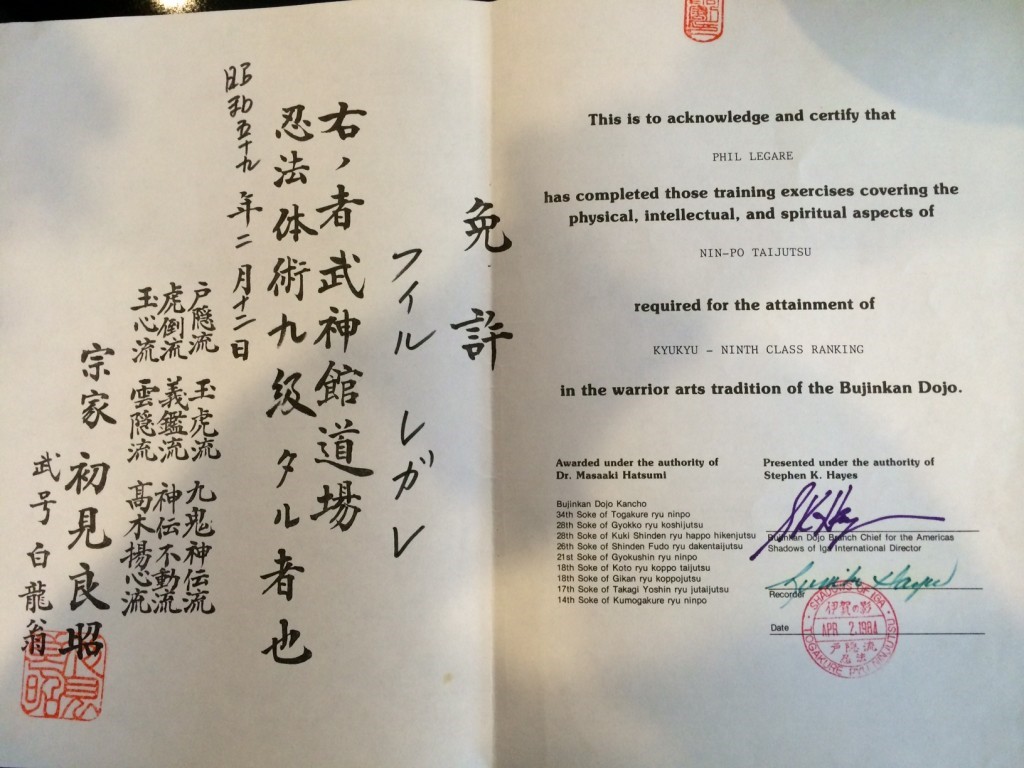
I think a few of the Bujinkan’s early Gaijin black belt instructors created their own rank menkyo, patches and membership cards because this is what they had done in their previous martial art. Or maybe they weren’t Shidoshi yet, so they couldn’t order ranks from Soke at the time, but had to give out ranks to keep students in the dojo. Or possibly they just didn’t know how to go about ordering ranks the proper way back then. This may be why Soke found it necessary to publish the official Bujinkan guidelines that we are to follow.
I share this with you because it is an interesting part of my experiences in the Bujinkan. And I think it is important to understand how much the art has evolved under Hatsumi Sensei leadership and how far we ourselves have come as students of this art.
Leave a comment below and let me know if you have any follow up questions about rank or this article on Menkyo Defined. Again a special thanks to Shihan Brent Earlewine, Pittsburgh BTSD, for putting together this graphic depiction of a Shodan menkyo.
